
The Araceae are a family of monocotyledonous flowering plants in which flowers are borne on a type of inflorescence called a spadix. The spadix is usually accompanied by, and sometimes partially enclosed in, a spathe. Also known as the arum family, members are often colloquially known as aroids. This family of 140 genera and about 4,075 known species is most diverse in the New World tropics, although also distributed in the Old World tropics and northern temperate regions.

Alocasia is a genus of rhizomatous or tuberous, broad-leaved, perennial, flowering plants from the family Araceae. There are about 90 accepted species native to tropical and subtropical Asia and eastern Australia. Around the world, many growers widely cultivate a range of hybrids and cultivars as ornamentals.

Narthecium ossifragum, commonly known as bog asphodel, Lancashire asphodel or bastard asphodel, is a species of flowering plant in the family Nartheciaceae. It is native to Western Europe, found on wet, boggy moorlands up to about 1,000 m (3,300 ft) in elevation. It produces spikes of bright yellow flowers in summer. The bright orange fruits have been used as a colourant to replace saffron by Shetland Islanders. Despite the plant's English name "bog asphodel", it is not particularly closely related to the true asphodels. In addition to other forms of pollination, this plant is adapted to rain-pollination. The Latin specific name ossifragum means "bone-breaker", and refers to a traditional belief that eating the plant caused sheep to develop brittle bones. The probable origin of this story is that sheep eating a calcium-poor diet are likely to develop bone weakness, and N. ossifragum favours acidic low-calcium soils.
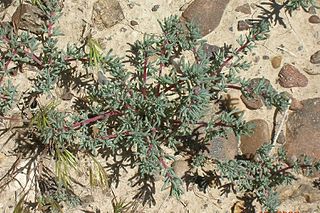
Halogeton glomeratus is a species of flowering plant in the family Amaranthaceae known by the common names saltlover, Aral barilla, and halogeton. It is native to Russia, Central Asia and China, but the plant is probably better known in the western United States, where it is an introduced species and a notorious noxious weed. This annual herb is a hardy halophyte, thriving in soils far too saline to support many other plants. It also grows in alkali soils such as those on alkali flats and disturbed, barren habitat. It can be found in sagebrush and shadscale habitat, and it grows well in areas with cold winters.

Raphides are needle-shaped crystals of calcium oxalate monohydrate or calcium carbonate as aragonite, found in more than 200 families of plants. Both ends are needle-like, but raphides tend to be blunt at one end and sharp at the other.

Tofieldiaceae is a family of flowering plants in the monocot order Alismatales. The family is divided into four genera, which together comprise 28 known species. They are small, herbaceous plants, mostly of arctic and subarctic regions, but a few extend further south, and one genus is endemic to northern South America and Florida. Tofieldia pusilla is sometimes grown as an ornamental.
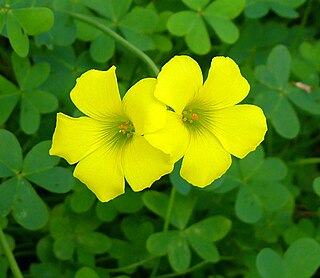
Oxalis pes-caprae is a species of tristylous yellow-flowering plant in the wood sorrel family Oxalidaceae. Oxalis cernua is a less common synonym for this species. Some of the most common names for the plant reference its sour taste owing to oxalic acid present in its tissues. Indigenous to South Africa, the plant has become a pest plant in different parts of the world that is difficult to eradicate because of how it propagates through underground bulbs.
NVC community CG10 is one of the calcicolous grassland communities in the British National Vegetation Classification system. Of the upland group of calcicolous grasslands, it is the only one with a short sward associated with heavy grazing.
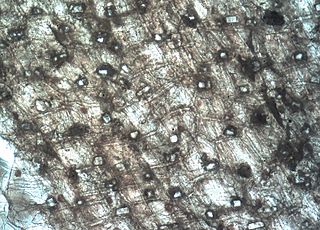
A druse is a group of crystals of calcium oxalate, silicates, or carbonates present in plants, and are thought to be a defense against herbivory due to their toxicity. Calcium oxalate (Ca(COO)2, CaOx) crystals are found in algae, angiosperms and gymnosperms in a total of more than 215 families. These plants accumulate oxalate in the range of 3–80% (w/w) of their dry weight through a biomineralization process in a variety of shapes. Araceae have numerous druses, multi-crystal druses and needle-shaped raphide crystals of CaOx present in the tissue. Druses are also found in leaves and bud scales of Prunus, Rosa, Allium, Vitis, Morus and Phaseolus.

Commelinoideae is a subfamily of monocotyledonous plants in the dayflower family (Commelinaceae). It is one of two subfamilies within the Commelinaceae and includes 39 genera and all but 12 of the family's several hundred known species. The subfamily is further broken down into two tribes, the Tradescantieae, which includes 26 genera and about 300 species, and the Commelineae, which contains 13 genera and about 350 species.

Kali tragus is a species of flowering plant in the family Amaranthaceae. It is known by various common names such as prickly Russian thistle, windwitch, or common saltwort. It is widely known simply as tumbleweed because in many regions of the United States, it is the most common and most conspicuous plant species that produces tumbleweeds. Informally, it also is known as "'salsola", which was its generic name until 2007.
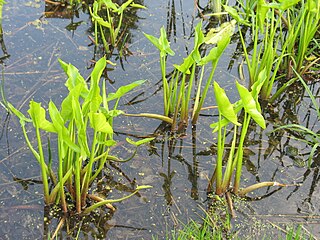
Peltandra virginica is a plant of the arum family known as green arrow arum and tuckahoe. It is widely distributed in wetlands in the eastern United States, as well as in Quebec, Ontario, and Cuba. It is common in central Florida including the Everglades and along the Gulf Coast. Its rhizomes are tolerant to low oxygen levels found in wetland soils. It can be found elsewhere in North America as an introduced species and often an invasive plant.
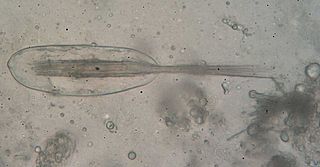
An idioblast is an isolated plant cell that differs from neighboring tissues. They have various functions such as storage of reserves, excretory materials, pigments, and minerals. They could contain oil, latex, gum, resin, tannin, or pigments etc. Some can contain mineral crystals such as acrid tasting and poisonous calcium oxalate, carbonate, or silica. Any of the tissue or tissue systems of plants can contain idioblasts. Idioblasts are divided into three main categories: excretory, tracheoid, and sclerenchymatous.
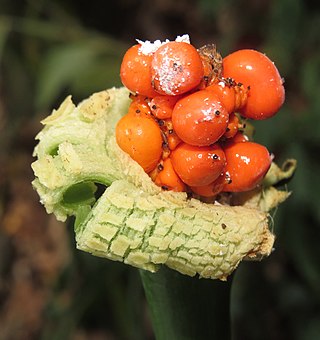
Alocasia fornicata is a plant species of many-nerved, broad-leaved, rhizomatous or tuberous perennials from the family Araceae, native to Indochina and to the Indian Subcontinent. It characteristically grows 2' - 3 ' in height with slightly pink petiole, triangular wide shaped leaves and a horizontally growing stolon.

Tofieldia is a small genus of flowering plants described as a genus in 1778. It is widespread across much of Europe, Asia, and North America.

Triantha is a small genus of flowering plants in the family Tofieldiaceae, first described as a genus in 1879. False asphodel is a common name for plants in this genus.

Cartonema is a genus of perennial or annual monocotyledonous flowering plants in the dayflower family. It is restricted to Australia and nearby Trangan Island, which is part of Indonesia. It is the earliest diverging member of its family and has a number of traits that are unique within it, such as non-succulent leaves and a lack of raphides. Its distinctive features led to the genus to once be considered part of its own separate family, Cartonemataceae. However, analysis of DNA sequences, as well as many common anatomical characters, has supported its relationship with the Commelinaceae. It contains about 11 species.

Thaumatophyllum xanadu is a perennial plant belonging to the arum family Araceae and the genus Thaumatophyllum, formerly classified under the Meconostigma subgenus of Philodendron. This plant is native to Brazil, but is widely cultivated as a landscape plant in tropical, subtropical and warm temperate climates.
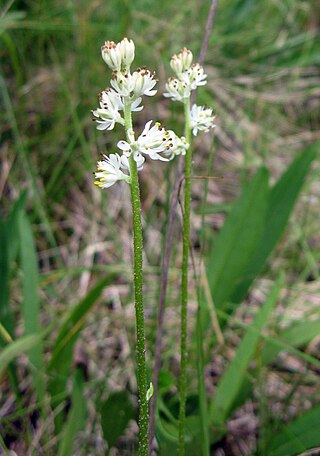
Triantha glutinosa is a species of flowering plant in the Tofieldiaceae family. It is commonly known as the sticky false asphodel, sticky tofieldia or northern bog asphodel, is a species of flowering plant in the tofieldia family.
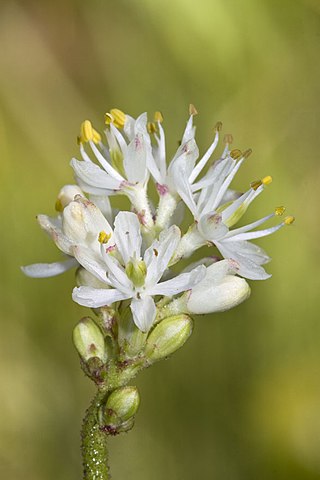
Triantha occidentalis, the western false asphodel, is a species of carnivorous flowering plant in the genus Triantha from the family Tofieldiaceae within the order of the Alismatales. It is found in the Pacific Northwest. It was recognised as a carnivorous plant in 2021, a rare occurrence within the Monocot clade.



















